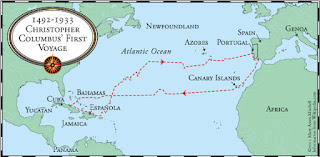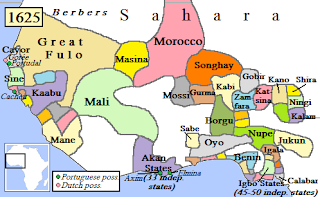christopher columbus fourth voyage: 1502- 1504
The disaster that was the third voyage essentially brought to a close the Columbus Era in
the New World. While other explorers, such as Amerigo Vespucci, believed that Columbus had found previously unknown lands, he stubbornly held to the claim that he had found the eastern edge of Asia and that he would soon find the markets of India, China and Japan. Although many at court believed Columbus to be mad, he was able to put together a fourth voyage, which as well as his previous three voyages will be financed by the Spanish crown.
and as promised we bring to your face the fourth and last visit and exploration of the great sealord to the 'new world'.
the New World. While other explorers, such as Amerigo Vespucci, believed that Columbus had found previously unknown lands, he stubbornly held to the claim that he had found the eastern edge of Asia and that he would soon find the markets of India, China and Japan. Although many at court believed Columbus to be mad, he was able to put together a fourth voyage, which as well as his previous three voyages will be financed by the Spanish crown.
and as promised we bring to your face the fourth and last visit and exploration of the great sealord to the 'new world'.
the fourth voyage:
The mission of the fourth voyage of Columbus was to find the straights of Malacca, which were thought to be in the vicinity (in reality still half a world away). After the fiasco of the third voyage, and his arrest, Columbus was kept on a tight leash for his fourth voyage. He was not allowed to visit the colony of Hispañola where he had ostensibly been made permanent and hereditary governor after his triumphant first voyage.
He was not allowed to trade, but to make discoveries, and attached to him was a royal commisioner who was to monitor his activities. Although the attachment was a record low for the master seafarer who was given the authority to explore the far and wide of the ocean.
Christopher Columbus made his fourth voyage, nominally in search of the Strait of Malacca to the Indian Ocean(which in reality is leagues away). On May 11, 1502, four old ships and 140 men under Columbus's command put to sea from the port of Cadiz. Among those accompanying him were his brother Bartholomew, and younger son Fernando, then thirteen years old. At age fifty-one, Columbus was sick, but felt he had one more voyage left in him.
He sailed to Arzila on the Moroccan coast to rescue the Portuguese soldiers who were being besieged by the Moors. On June 15, they landed at Carbet on the island of Martinique. A hurricane was forming so he continued on, hoping to find shelter on Hispaniola.
Columbus arrived at Santo Domingo on June 29, 1502, and requested that he be allowed to enter the harbor to shelter from the imminent hurricane. He also warned the treasure fleet gathering in the harbour not to put to sea till the the storm had passed. Nicolas de Ovando, the local governor, ignored the warning and the treasure fleet put to sea. Columbus sheltered his own ships in a nearby estuary, and all four ships survived the storm with moderate damage.
The large fleet was, however, caught by the storm, and twenty ships were lost, with them Bobadillo, Roldan, and the gold destined for the Crown. The admiral's share of the gold, four thousand pieces, was not lost, and on arriving delivered in Spain, was not confiscated. Hence Columbus should have had large funds for his retirement.
After a short stop at Jamaica, Columbus then sailed to Central America, arriving at Guanaja (Isla de Pinos) in the Bay Islands off the coast of Honduras on July 30 1502. On August 14, he landed on the American mainland at Puerto Castilla, near Trujillo, Honduras. He spent two months exploring the coasts of Honduras, Nicaragua, and Costa Rica, before arriving in Almirante Bay, Panama on October 16 1502.
When they arrived at present-day Panama, they learned from the natives that there was another ocean just a few days march to the south. This convinced Columbus that he was near enough the strait that he had proved his point about this being the Far East. In addition
the natives had many gold objects for which the Spaniards traded.
Beset by storms and contrary winds, Columbus finally returned to the mouth of the Rio Belen (western Panama) on January 9, 1503, and building a garrison fort there as he explored the area. As he was preparing to return to Spain, he took three of his ships out of the river, leaving one with the garrison. April 6, a large force of Indians attacked the garrison. The Spanish managed to hold off the attack, but lost a number of men and realized that the garrison could not be held for long. Columbus rescued the remaining members of the garrison, losing one of his ships in the process. The three remaining ships, now badly leaking from shipworm, sailed for home on April 16.
Off the coast of Cuba, they were hit by yet another storm, the last of the ship's boats was lost, and one of the caravels was so badly damaged that she had to be taken in tow by the flagship. Both ships were leaking very badly now, and water continued to rise in the hold in spite of constant pumping by the crew. Finally, able to keep them afloat no longer, Columbus beached the sinking ships in St. Anne's Bay, Jamaica, on June 25, 1503. Since there was no Spanish colony on Jamaica, they were marooned.
Columbus and his men were stranded on Jamaica for a year. Diego Mendez, one of Columbus's captains, bought a canoe from a local chief and sailed it to Hispaniola. He was promptly detained by governor Ovando outside the city for the next seven months, and was refused use of a caravel to rescue the expedition.
In a desperate effort to get the natives to continue provisioning him and his hungry men, he successfully wowed the natives by correctly predicting a lunar eclipse, using astronomic tables made by Rabbi Avraham Zacuto of Spain. In addition half of those left on Jamaica staged a mutiny against Columbus, which he eventually put down. When Ovando finally allowed Mendez into Santo Domingo, there were no ships available for the rescue. Finally, Mendez was able to charter a small caravel, which arrived at Jamaica on June 29, 1504, and rescued the expedition.
Columbus returned home to Spain on November 7, 1504, his last voyage complete.
He sailed to Arzila on the Moroccan coast to rescue the Portuguese soldiers who were being besieged by the Moors. On June 15, they landed at Carbet on the island of Martinique. A hurricane was forming so he continued on, hoping to find shelter on Hispaniola.
Columbus arrived at Santo Domingo on June 29, 1502, and requested that he be allowed to enter the harbor to shelter from the imminent hurricane. He also warned the treasure fleet gathering in the harbour not to put to sea till the the storm had passed. Nicolas de Ovando, the local governor, ignored the warning and the treasure fleet put to sea. Columbus sheltered his own ships in a nearby estuary, and all four ships survived the storm with moderate damage.
The large fleet was, however, caught by the storm, and twenty ships were lost, with them Bobadillo, Roldan, and the gold destined for the Crown. The admiral's share of the gold, four thousand pieces, was not lost, and on arriving delivered in Spain, was not confiscated. Hence Columbus should have had large funds for his retirement.
After a short stop at Jamaica, Columbus then sailed to Central America, arriving at Guanaja (Isla de Pinos) in the Bay Islands off the coast of Honduras on July 30 1502. On August 14, he landed on the American mainland at Puerto Castilla, near Trujillo, Honduras. He spent two months exploring the coasts of Honduras, Nicaragua, and Costa Rica, before arriving in Almirante Bay, Panama on October 16 1502.
When they arrived at present-day Panama, they learned from the natives that there was another ocean just a few days march to the south. This convinced Columbus that he was near enough the strait that he had proved his point about this being the Far East. In addition
the natives had many gold objects for which the Spaniards traded.
Beset by storms and contrary winds, Columbus finally returned to the mouth of the Rio Belen (western Panama) on January 9, 1503, and building a garrison fort there as he explored the area. As he was preparing to return to Spain, he took three of his ships out of the river, leaving one with the garrison. April 6, a large force of Indians attacked the garrison. The Spanish managed to hold off the attack, but lost a number of men and realized that the garrison could not be held for long. Columbus rescued the remaining members of the garrison, losing one of his ships in the process. The three remaining ships, now badly leaking from shipworm, sailed for home on April 16.
Off the coast of Cuba, they were hit by yet another storm, the last of the ship's boats was lost, and one of the caravels was so badly damaged that she had to be taken in tow by the flagship. Both ships were leaking very badly now, and water continued to rise in the hold in spite of constant pumping by the crew. Finally, able to keep them afloat no longer, Columbus beached the sinking ships in St. Anne's Bay, Jamaica, on June 25, 1503. Since there was no Spanish colony on Jamaica, they were marooned.
Columbus and his men were stranded on Jamaica for a year. Diego Mendez, one of Columbus's captains, bought a canoe from a local chief and sailed it to Hispaniola. He was promptly detained by governor Ovando outside the city for the next seven months, and was refused use of a caravel to rescue the expedition.
In a desperate effort to get the natives to continue provisioning him and his hungry men, he successfully wowed the natives by correctly predicting a lunar eclipse, using astronomic tables made by Rabbi Avraham Zacuto of Spain. In addition half of those left on Jamaica staged a mutiny against Columbus, which he eventually put down. When Ovando finally allowed Mendez into Santo Domingo, there were no ships available for the rescue. Finally, Mendez was able to charter a small caravel, which arrived at Jamaica on June 29, 1504, and rescued the expedition.
Columbus returned home to Spain on November 7, 1504, his last voyage complete.
Columbus returned to Spain to learn that his beloved Queen Isabel was dying. Without her support, Columbus would never return to the New World. He was getting on in years at any rate, and it is a wonder that he survived the disastrous fourth voyage. He died in 1506.
 |
| diego columbus |
Columbus’ Fourth Voyage is remarkable primarily for some new exploration, mostly along the coast of Central America. It is also of interest to historians, who value the descriptions of the native cultures encountered by Columbus’ small fleet, particularly those sections concerning the Mayan traders. Some of those who were along on the fourth voyage would later go on to greater things, such as Antonio de Alaminos, a cabin boy who would later rise to pilot and explore much of the western Caribbean. Columbus’ son Fernando would later write a biography of his famous father.





Comments
Post a Comment